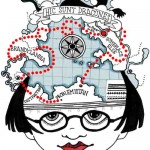Decided to tweak this blog's navigation today. I want to make navigation more intuitive -…
Mental maps: Recording, retaining, retrieving …
 Quote voice-over video “Childhood Storage” by Anna-Nicole Ziesche, Boijmans, ‘The Art of Fashion’ october ’09
Quote voice-over video “Childhood Storage” by Anna-Nicole Ziesche, Boijmans, ‘The Art of Fashion’ october ’09
” Recording, retaining, retrieving or fixating, filing, finding. Recalling, Recognizing. How is it possible to lead a ‘normal’ life by possessing a memory with all existing files past and present being scattered all over the place? How is it possible to walk through life and come so far by being intellectually uniquely lazy? Recording, retaining, retrieving, fixating, filing, finding: when memory is not filled clearly it is inaccessible recalling, recognising and relearning are methods of measuring memory.”
The following are my questions & thoughts – need to check this subject researching psychologists.
What do we have mental maps about? Maybe there is some sort of order?
Body > place we live > neighborhood > city > country > earth
Mental map of the body is what a baby starts with. Where our limbs are in relation to the rest of the body., the way our bodies function. This mental map becomes so strong that when a limb is amputated, in our minds we still have it & we can feel it itch or have pain there. Mental map of the mothers body?
A toddler builds a mental map about the place she lives in (house, garden). When I go looking for my keys that I have lost I first search the mental map of my house, sort of consult the map of where I have been in the house recently, before I go looking.
A young kid (school going age) builds a mental map of her neighborhood. Ricolt’s mental map is peopled with cars, mine with trees, shrubs and plants
A teenager builds a mental map of the city she lives in, work sin or visits. I consult this mental map when locating a new place to go. Feel lost when I cannot place myself on a mental map of the city I am in (this is the Tomtom effect)
Teenagers and grownups build a mental map of the country they live in / were born in. This is where I picked up the term ‘mental map’. I once read about a project where people were asked to draw a map of, say, Holland. By measuring the distances between the main cities one could see where the person that drew the map was born, for the cities around that place are given a too long distance between them, the cities further away are give a too small distance.
About earth (flat or sphere), heaven (paradise)? Universe (big bang)?
Why do we have mental maps?
Making mental maps = the business of growing up. Baby first makes mental map of it’s body, toddler adds house, kid adds neighborhood, adult addes citiy and country (heaven?).
What influence is your belief system? Does believing that trees are inhabited by driads and streams by goddesses gives one an different mental map? Research aboriginal dreamtime and their pictures as mental maps of their land.
Mental map is a spatial thing – a representation in your mind of where things are (body parts – houses – cities) and how they relate to each other. Why we need them: anecdote: One of my uncles worked as a firefighter. When on duty he and his colleagues used to sleep at the station. They played a prank on an new member of the force once – when he was asleep, they turned his bed 180 degrees around, so the wall was to the other side of him. Then they sounded the alarm, and sure enough, he tried to leap out of bed and hurled himself against the wall. Meaning: we have mental maps to be able to react to danger/dangerous situations very quickly.
The linear model of stimulus-response is too simple. We evaluate new input against our mental map and then (maybe subconsciously?) decide to pay attention to the stimulus or not, and what action is required.
Are mental maps made/retained by words? Urban legends?
Mental maps – bodies of the mind ??
Mental maps – cities of the mind? Personal mindmaps of cities past: Carmiggelt’s Amsterdam was peopled with pubs. Mindmaps of cities present: Orhan Pamuk about Istanbul. Mindmaps of future cities: Asimov
Mental maps – landscapes of the mind, gardens of the mind. Derek Yarman: ‘paradise haunts gardens, as it haunts mine’.
Interesting to research how mental maps are made, how and why they become fixed and why we need them fixed.
Wiki’s suggested reading:
Stanley Milgram – psychologist of ‘Peer Adminsters Shocks’ fame (Experiment 18: A Peer Administers Shocks).
cognitive models of geographical space
Downs , Roger M.; David Stea. (1973). Image & environment : cognitive mapping and spatial behavior (en) . Chicago: Aldine Pub. Co.. ISBN 978-02-021-0058-6.
Golledge , Reginald G.; Gerard Rushton. (1976). Spatial choice and spatial behavior : geographic essays on the analysis of preferences and perceptions (en) . Columbus: Ohio State University Press. ISBN 978-08-142-0241-8.
Golledge , Reginald G. (1993). Behavior and Environment: Psychological and Geographical Approach (en) . Amsterdam: Elsevier Science Publishers. ISBN 978-04-448-9698-8.
| « Rhizomes and Phyllotaxis | <-- previous post | next post --> | Experiment no 003/2009: next step » |
|---|








